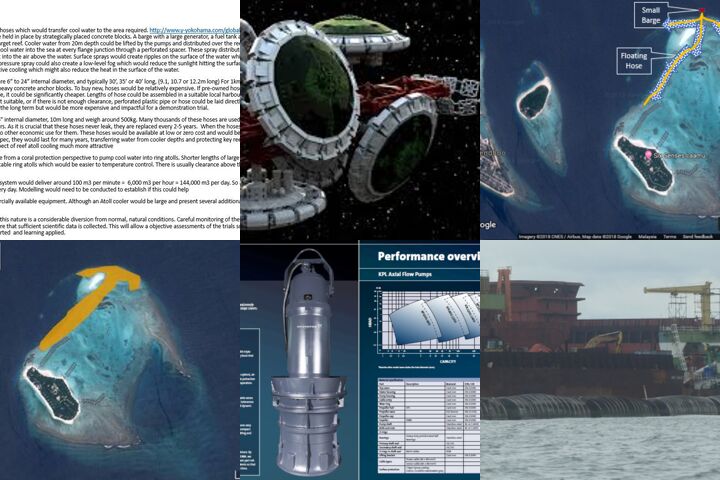Large Scale Coral Cooling
The Problem
Work is underway to find ways to improve the resilience of coral reefs around the world. Options for preserving large, viable diverse populations of coral are limited. When bleaching events occur, large areas of diverse coral are lost. After the bleaching event has passed, corals recover to some extent, but typically with much reduced diversity. This reduces the health of the reef and its value as a marine habitat. Coral reef declines have been recorded for all major tropical ocean basins since the 1980s, averaging approximately 30-50% reductions in reef cover globally. These losses are a result of numerous problems, including habitat destruction, pollution, overfishing, disease, and climate change. Back-to-back mass coral bleaching events in 2015-2016 and 2017 have resulted in dramatic coral die-offs. For the hundreds of millions of people who depend on reefs for food or livelihoods, the thousands of communities that depend on reefs for wave protection, the people whose cultural practices are tied to reef resources, and the many economies that depend on reefs for fisheries or tourism, the health and maintenance of this major global ecosystem is crucial. This report from The National Academy of sciences reviews of research on 23 approaches to increase the persistence and resilience of reefs. http://www8.nationalacademies.org/cp/projectview.aspx?key=49916
Our Proposal
This Floating Hoses proposal is offered as a concept that could aid the survival of a small number of reefs at times of extreme heat stress. It is not a permanent cure, but could provide a means of allowing diverse, viable populations of key corals to survive from one season to the next. This is a stop-gap measure to buy time while better solutions are put in place. FLOATING HOSES FOR REEF COOLING. The main principles of this proposal are very simple. • Coral reefs are damaged by hot surface water. Water is often cooler 20m below the surface - Therefore, if the cooler water could be lifted to the surface, selected areas of the reef could be cooled. • To cool useful areas of reef, large amounts of water need to be moved - Very large submerged pumps, floating hoses and generators are used in various different industries. This type of equipment could be used to lift massive volumes of cooler water onto a reef. • There is significant water movement across open reefs, making the amount of water to be moved very large - Coral Atolls may have lower water exchange than fully open reefs. It may be more practical to manage the temperature range in a closed atoll or restricted flow area. • Large scale solutions are urgently needed - The necessary equipment already exists and could be hired at short notice to do a demonstration trial.
We Assume that...
A suitable trial site can be identified. Initial work would not need to be done on a sensitive site.
That a $ value can be identified for the protection of a given area of reef. Is a hectare of preserved reef worth 100, 10,000 or 1,000,000 USD to the local and global community?
Barge, pump, generators, anchors and other equipment can be hired.
A suitable funder would be able to support the initial and subsequent trials.
Used floating hoses are available at low cost.
Constraints to Overcome
The equipment required to conduct this trial is available. Some modelling of water flows would be required. It is understood that AIMS in Australia has done some work on modelling of this type, and an early stage of the project would be to discuss this in detail with AIMS. Thereafter, the main challenges are identifying a partner willing to conduct a trial and cost. How much would it cost to hire the equipment and how does this relate to the perceived value of a reef? If the modelling suggests that a trial could be worthwhile, the next step would be a detailed costing of the necessary equipment. Kit of parts: - Supply boat (with a small derrick crane) - Generators (or use a diesel-electric supply boat) - Floating hoses – enough for a trial, but not long term - Connectors - Concrete blocks as anchors - Fuel For a trial to proceed, a suitable funder and project location would need to be identified.
Current Work
The next step in the project is to connect with AIMS and other groups able to do ocean temperature distribution modelling to understand what work has been done so far and how this cooling project would fit in. If modelling looks encouraging, a detailed costing will be conducted. It will also be important to understand the $ value of reef areas to users. How much are the interested parties willing to pay to protect key areas of reef? Access to AIMS team and similar groups working on temperature modelling. Detailed equipment costs. Development of a detailed trial cost with a potential equipment supplier.
Current Needs
This project is an 'emergency room' solution which would not address the root cause of the problem but which would buy time for particular coral reefs and allow the species to continue to produce larvae and have the opportunity to adapt to changing ocean conditions. If this project is selected as one the 20 the funds will be used to prepare a detailed costing and start discussions with AIMS and other reef focussed bodies. If the project is selected for larger funding, contact will be established with other reef groups and discussions started with groups in the Maldives about suitable trial locations - we already have existing contacts in the Maldives. If this funding can come from a well know organisation, the name would help to smooth the path of the project. We already have some contacts in Malaysia and the Maldives who might be interested in hosting a trial if it were externally funded.
